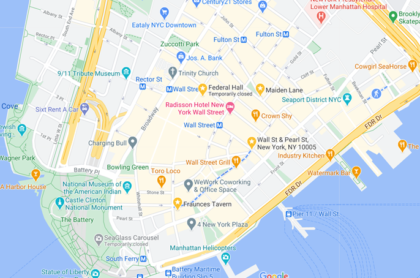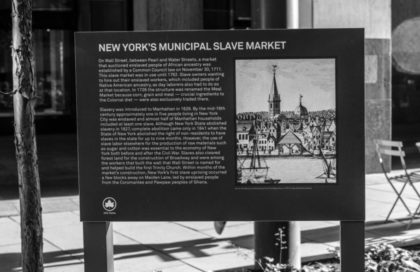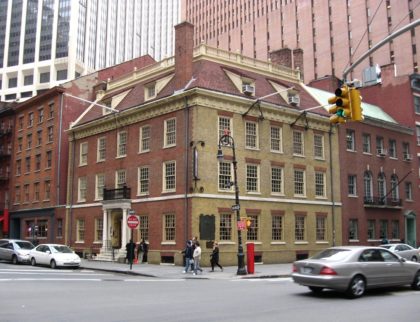Field Trip: Lower Manhattan as Black history
The Downtown Alliance blog is doing a series written by Black Gotham Experience’s Kamau Ware on downtown landmarks and their connection to Black history — and of course New York history. I’ve excerpted the series here and made the map above if you want to take a walk; the links to the full entries are below.
A FIRST REBELLION ON MAIDEN LANE
The first recorded militarized Black rebellion on the island of Manhattan took place at Broadway and Maiden Lane on April 6, 1712. Over two-dozen armed enslaved Black people carried out a plot to set a fire that would lead to an ambush. This act of rebellion doesn’t have a name like the Stono Rebellion or Shay’s Rebellion, and the site is unmarked. The rebels planned and carried out this attack less than five months after the Common Council established a slave market on Pearl Street and Wall Street.
THE SLAVE MARKET AT PEARL AND WALL
New York City was born out of the English Slave Trade in 1664. On November 30, 1711, the Common Council of New York City established a slave market at the corner of Pearl Street and Wall Street to regulate the selling of Black bodies. A commemorative plaque was placed on the corner of Water Street and Wall Street in 2015 to acknowledge this history, but the actual site of the market is one block west.
THE NEW YORK CONSPIRACY AT FEDERAL HALL
Known as The New York Conspiracy and renamed The Great Negro Plot in the early 1800s, this New York Supreme Court case sought to find the conspirators and masterminds behind a plot to usurp British authority and replace it with a working-class Irishman as king and an enslaved African as governor.
BLACK SAM
Some historians consider Samuel Fraunces, of Fraunces Tavern, Black, or at least of mixed ancestry. “Fraunces, affectionately known as “Black Sam” after the American Revolution, is such an enigma. Stories of his origins are unclear, but some point to the West Indies. What is clear is that Fraunces was a revolutionary before he met Washington of Virginia, and Sam’s Queen’s Head Tavern was a place where revolutionaries could meet and plot. Washington chose Fraunces’ place to bid farewell to his troops at the conclusion of the American Revolution.”
KWAKU AT BOWLING GREEN
In the middle of the park is the missing equestrian statue of King George III, toppled in 1776 under the direction of General Washington, as a poignant ceremonial beginning to the American Revolution. Directly adjacent to Bowling Green is the site of Fort Amsterdam, built in part by enslaved labor around 1626. This is the same structure that was renamed Fort George in the time of English New York in the 1700s. During the rebellion known as the Great Negro Plot, the fort was set ablaze by the enslaved African named Kwaku on March 18, 1741. This fire troubled the grandfather of King George III and is part of our lineage of rebellious New Yorkers seeking freedom.
















General Washington did *not* direct the toppling of King George’s statue.
He ordered a reading of the Declaration of Independence, newly arrived in the City, to his soldiers by the commanders on the Common, near the present day location of City Hall, not at Bowling Green.
Those orders included the following: “The General hopes this important Event will serve as a fresh incentive to every officer, and soldier, to act with Fidelity and Courage, as knowing that now the peace and safety of his Country depends (under God) solely on the success of our arms: And that he is now in the service of a State, possessed of sufficient power to reward his merit, and advance him to the highest Honors of a free Country.”
Some soldiers and Sons of Liberty then headed that evening down to Bowling Green, a mile away, and took down the statue, parts of which can be seen at the New York Historical Society.
There was nothing ceremonial about the toppling of the statue, and “poignant” seems too classy IMO to describe the mob action. In fact, in Washington’s own ‘General Orders Book’ for July 10, 1776, the daily entry states:
” ‘Tho the General doubts not the persons, who pulled down and mutilated the Statue, in the Broadway, last night, were actuated by Zeal in the public cause; yet it has so much the appearance of riot, and want of order, in the Army, that he disapproves the manner, and directs that in future these things shall be avoided by the Soldiery, and left to be executed by proper authority.”
James, as always, amazing.